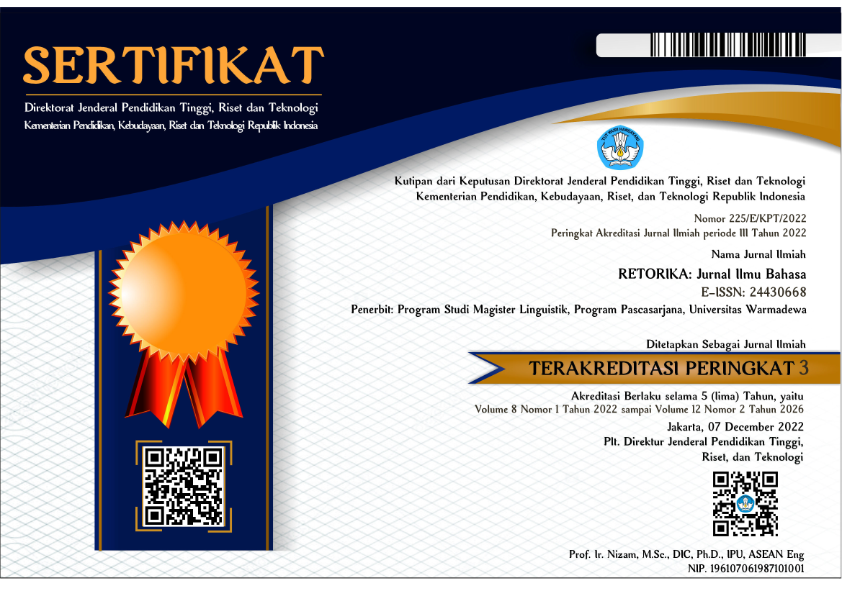THE MEANING OF THE SIGN OF PASOLA SHOW IN WAIHURA VILLAGE WANOKAKA SUB-DISTRICT, WEST SUMBA REGENCY: A STUDY OF SEMIOTICS
Abstract
This paper discusses the study of semiotics on the meaning of the sign of Pasola show in Waihura Village Wanokaka District, West Sumba Regency. This study aims at describing how the meaning and form of the sign in the implementation of Pasola show in Wanokaka community. This study was conducted on the basis of Pierce's semiotics theory in Aart (1993). The design of this research was descriptive qualitative. The data was obtained from the speech of the performers of Pasola called Rato. Method and technique of data collection were observation and interview. Observation was used to obtain the data of the implementation process and the signs involved in the Pasola show, while the interview was used to obtain the spoken data used and the meaning in Pasola's references. From the results of data analysis it was found that in Pasola show there are twenty marks, such as mamoli (earring), nibbu (spear), profit (drum), katopu (machete), karera (bag), katala (gong), whung, koba (bowl), kalabi (shirt), rowa rara (red sash), rowa metung (black sash), laiku (rope), leli (ring), reba (place to eat), winu (betel nut), rato (Customary ruler), arera (betel nut), lagoru (dribble), rahi dara (horse control), regi (cloth), horse equipments, Pasola player, lado, hela, kadu watu, Rato position. The meaning of these signs is as a symbol of fertility for women, symbolizing splendor. Dragon symbolizes the entry of the holy month that all the restrictions must be followed, symbolizing the unity of society in running the life of society, symbolizing the majesty of a king, the moon gives a hint of the passage of Pasola, the symbol of life Wanokaka society.References
Aminudin. (1997). Stilistika Pengantar Memahami Bahasa dalam Karya sastra. Semarang: IKIP Semarang Press.
Bamualin, A. (2009). Profil Budaya Sumba Barat. Waikakbubak: Dinas Kebudayaan Pariwisata Kabupaten Sumba Barat.
Bamualin, Anisah. 2013. Kebudayaan sumba barat. Dinas Kebudayaan dan Pariwisata Kabupaten Sumba Barat.
Iskandar.2009. Metodelogi Penelitian Kualitatif. Aplikasi untuk Penelitian Pendidikan,
Kridalaksana, Harimurti. 2001. Kamus Linguistik. Jakarta: Gramedia pustaka utama.
Moleong, Prof. Dr. Lexy J. 2010. Metodologi Penelitian Kualitatif Edisi Revisi. Bandung: PT. Remaja Rosda karya..
Santoso, Eko, dkk. 2008. Seni Teater Jilid II. Jakarta: Direktorat Pembinaan Sekolah Menengah Kejuruan, Direktorat Jenderal Manajemen Pendidikan Dasar dan Menengah, Departemen Pendidikan Nasional.
Sobur, Alex. 2004. Analisis Teks Media. Bandung: Remaja Rosdakarya
Sugiyono,Prof. Dr. 2012. Metode Penelitian Kuantitatif Kualitatif dan R&D. Bandung. Penerbit Alfa beta Bandung.
Sugiyono.Prof. Dr. 2011.Metode Penelitian Kombinasi. Bandung: Alfa beta.
Sudaryanto, 2015. Metode dan aneka teknik analisa bahasa.Yogyakarta. Sanata Darma University Press
Zaimar.Okke K.S. 2008. Semiotik dan Penerapannya Dalam Karya Sastra. Jakarta: Pusat Bahasa Departemen Pendidikan Nasional.
Zoest, A. van. (1993). Semiotika: Tentang Tanda, Cara Kerjanya dan Apa yang kita Lakukan Dengannya. Jakarta: Yayasan Sumber Agung.
Zoest, A. van. (1996). Serba-serbi Semiotika. Jakarta: Gramedia Pustaka Utama.
Copyright (c) 2018 RETORIKA: Jurnal Ilmu Bahasa

This work is licensed under a Creative Commons Attribution-ShareAlike 4.0 International License.
This journal provides immediate open access to its content on the principle that making research freely available to the public supports a greater global exchange of knowledge.
All articles published Open Access will be immediately and permanently free for everyone to read and download. We are continuously working with our author communities to select the best choice of license options, currently being defined for this journal as follows: Creative Commons-Non Ceomercial-Attribution-ShareAlike (CC BY-NC-SA)
 Abstract viewed = 515 times
Abstract viewed = 515 times
 PDF downloaded = 515 times
PDF downloaded = 515 times

2.png)














